Pistolet-pulemet (Пистоле́т-пулемёт) means submachine gun in Russian. The name is most often used in relation to a series of weapons made by the Soviet Union which includes PPD-40, PPSh-41 and PPS-43. The letter after the PP (ПП) in the gun's designation is from the designer's name. For example, the "Sh" in PPSh stands for Shpagin.

The 7.62×25mm Tokarev cartridge is a Russian rimless bottlenecked pistol cartridge widely used in former Soviet satellite states, and in China and Pakistan among other countries. The cartridge has since been replaced in most capacities by the 9×18mm Makarov in Russian service.

A revolver cannon is a type of autocannon, commonly used as an aircraft gun. It uses a cylinder with multiple chambers, like those of a revolver handgun, to speed up the loading-firing-ejection cycle. Some examples are also power-driven, to further speed the loading process. Unlike a rotary cannon, a revolver cannon has only a single barrel, thus its spun weight is lower. Automatic revolver cannon have been produced by many different manufacturers.
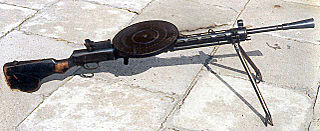
The Degtyaryov machine gun or DP-27 is a light machine gun firing the 7.62×54mmR cartridge that was primarily used by the Soviet Union, with service trials starting in 1927 followed by general deployment in 1928. Besides being the standard Soviet infantry light machine gun (LMG) during WWII, with various modifications it was used in aircraft as a flexible defensive weapon, and it equipped almost all Soviet tanks in WWII as either a flexible bow machine gun or a co-axial machine gun controlled by the gunner. It was improved in 1943 producing the DPM, but it was replaced in 1946 with the RP-46 which improved on the basic DP design by converting it to use belt feed. The DP machine gun was supplemented in the 1950s by the more modern RPD machine gun and entirely replaced in Soviet service by the general purpose PK machine gun in the 1960s.
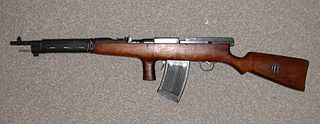
The Fedorov Avtomat or FA was a select-fire, "handheld light-machine-gun", designed by Vladimir Grigoryevich Fyodorov in 1915 and produced in the Russian Empire and later in the Russian Soviet Federative Socialist Republic. A total of 3,200 Fedorov rifles were manufactured between 1915 and 1924 in the city of Kovrov; the vast majority of them were made after 1920. The weapon saw combat in World War I, but was used more substantially in the Russian Civil War and in the Winter War.
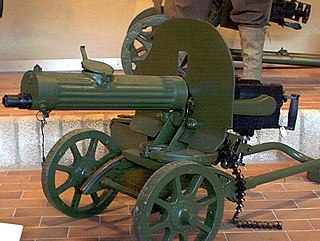
The PM M1910 was a heavy machine gun used by the Imperial Russian Army during World War I and the Red Army during Russian Civil War and World War II. Later, the gun saw service in the Korean War and the Vietnam War, and some have been spotted in the War in Donbass.

The ZPU is a family of towed anti-aircraft gun based on the Soviet 14.5×114mm KPV heavy machine gun. It entered service with the Soviet Union in 1949 and is used by over 50 countries worldwide.
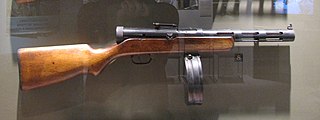
The PPD is a submachine gun originally designed in 1934 by Vasily Degtyaryov. The PPD had a conventional wooden stock, fired from an open bolt, and was capable of selective fire. It was replaced by the PPSh-41.

The PPSh-41 ; is a Soviet submachine gun designed by Georgy Shpagin as a cheap, reliable, and simplified alternative to the PPD-40. Common nicknames are "pe-pe-sha" from its three-letter acronym and "papasha", meaning "daddy".
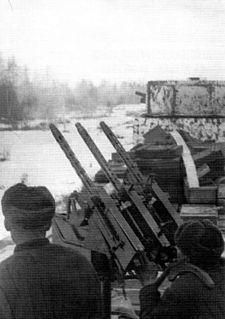
PV-1 is a Soviet air-cooled version of the Russian M1910 Maxim for mounting on aircraft. It was designed between 1926 and 1927. The first prototypes were produced and accepted into service in 1928.
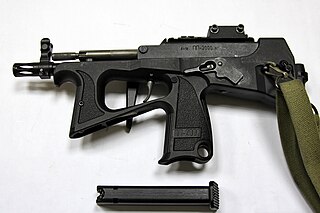
The PP-2000 is a submachine gun/machine pistol made by the KBP Instrument Design Bureau. It was first publicly displayed at the Interpolytech-2004 exhibition in Moscow even though its patent was filed in 2001 and issued in 2003.

The Maxim–Tokarev was the first domestic Soviet light machine gun accepted for service. It was based on the Maxim M1910.

The RPD is a 7.62mm light machine gun developed in the Soviet Union by Vasily Degtyaryov for the 7.62×39mm M43 intermediate cartridge. It was created as a replacement for the DP machine gun chambered for the 7.62×54mmR round. It is a precursor of most squad automatic weapons. It was succeeded in Soviet service by the RPK.

The Tokarev Model 1927 submachine gun was an experimental firearm developed in the Soviet Union under the leadership of Fedor Vasilievich Tokarev as part of the Soviet Unions drive to be self sufficient in armaments. It was a blowback-operated, two trigger weapon which fired a 7.62 mm round originally intended as a pistol round.
The SN was an aircraft machine gun manufactured in small numbers in the Soviet Union before World War II.

The PPS is a family of Soviet submachine guns chambered in 7.62×25mm Tokarev, developed by Alexei Sudayev as a low-cost personal defense weapon for reconnaissance units, vehicle crews and support service personnel.
The Garanin machine guns were a series of general-purpose machine gun prototypes developed by Soviet designer Georgy Semenovich Garanin at OKB-575 in Kovrov. These guns were developed in the context of a contest, started in December 1955, for replacing the company-level RP-46 light machine gun and the battalion-level "heavy" machine gun SGM with a single new machine gun that could fulfill both roles using different mounts.

The 7.62×39mm round is a rimless bottlenecked intermediate cartridge of Soviet origin that was designed during World War II. Due to the worldwide proliferation of the Soviet SKS and AK-47 pattern rifles, as well as RPD and RPK light machine guns, the cartridge is used by both militaries and civilians alike. 7.62×39mm ammunition is purportedly tested to function well in temperatures ranging from −50 to 50 °C cementing its usefulness in cold polar or hot desert conditions.

The PU-21 is a 5.45x39mm machine gun designed by V. M. Kalashnikov and M. E. Dragunov between 1972 and 1977. The PU-21 can be fed from either a 45-round magazine or a 200-round belt. The PU-21's sights are graduated to distance of 1000 m.

The LAD machine gun is a Soviet prototype light machine gun. Although belt-fed and having a built-in bipod, it is chambered for the Tokarev pistol cartridge. The LAD gun was developed between 1942 and 1943 by V. F. Lyuty, N. M. Afanasyev and V. S. Daykin. Only two prototypes were built and it was not accepted for service.




















